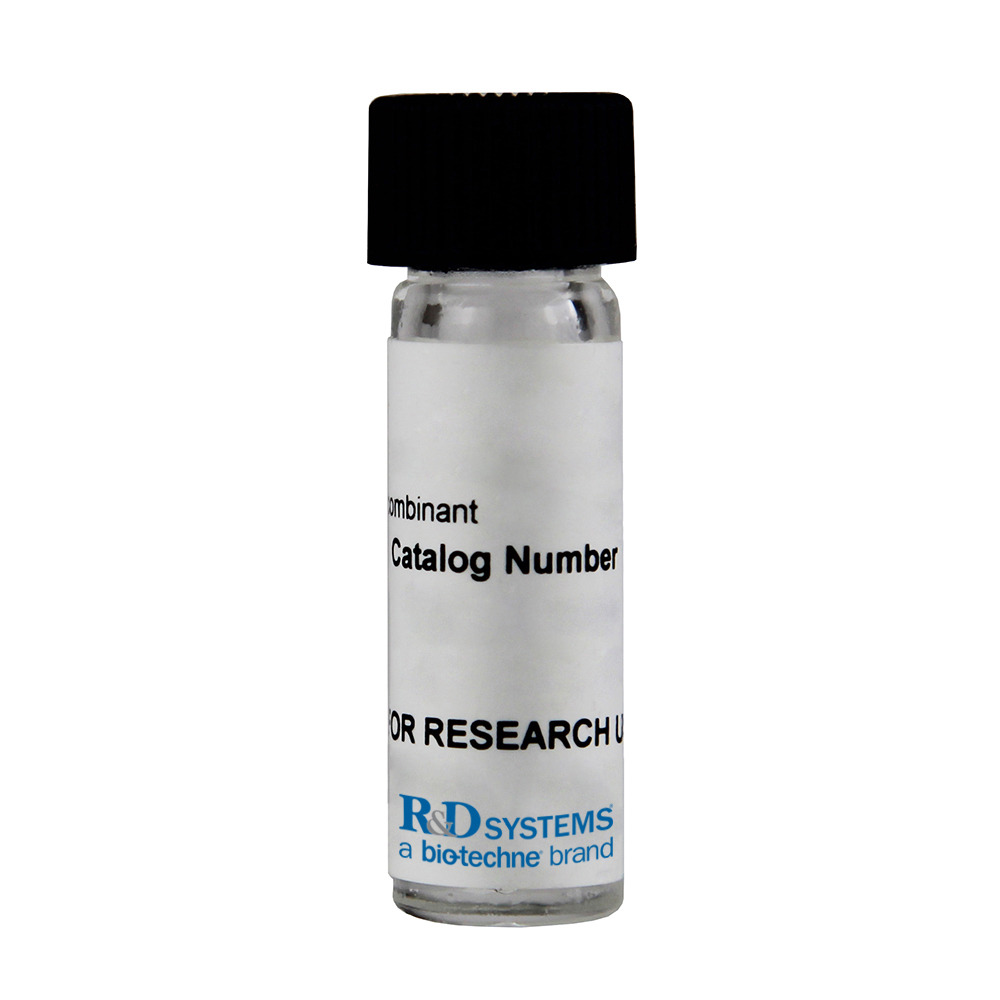

 下载产品说明书
下载产品说明书 下载SDS
下载SDS 用小程序,查商品更便捷
用小程序,查商品更便捷



 收藏
收藏
 对比
对比 咨询
咨询Carrier Free
CF stands for Carrier Free (CF). We typically add Bovine Serum Albumin (BSA) as a carrier protein to our recombinant proteins. Adding a carrier protein enhances protein stability, increases shelf-life, and allows the recombinant protein to be stored at a more dilute concentration. The carrier free version does not contain BSA.
In general, we advise purchasing the recombinant protein with BSA for use in cell or tissue culture, or as an ELISA standard. In contrast, the carrier free protein is recommended for applications, in which the presence of BSA could interfere.
2859-SL
| Formulation | Lyophilized from a 0.2 μm filtered solution in PBS with Trehalose. |
| Reconstitution | Reconstitute at 100 μg/mL in sterile PBS. |
| Shipping | The product is shipped at ambient temperature. Upon receipt, store it immediately at the temperature recommended below. |
| Stability & Storage: | Use a manual defrost freezer and avoid repeated freeze-thaw cycles.
|
Recombinant Human Siglec-6/CD327 Fc Chimera Protein, CF Summary
Product Specifications
| Human Siglec-6 (Gln27-Val331) Accession # NP_942142 | IEGRMD | Human IgG1 (Pro100-Lys330) |
| N-terminus | C-terminus | |
Analysis

Background: Siglec-6/CD327
Siglecs (sialic acid binding Ig-like lectins) are I-type (Ig-type) lectins that belong to the Ig superfamily. They are characterized by an N-terminal Ig-like V-type domain which mediates sialic acid binding, followed by varying numbers of Ig-like C2-type domains (1 - 4). Eleven human Siglecs (Siglec-1 through 11) have been cloned and characterized. Within these eleven, there are at least two groups, one of which is termed the CD33-related group. CD33-related Siglecs include CD33/Siglec-3 and Siglec-5 through 11 (1, 3). To date, no Siglec has been shown to recognize any cell surface ligand other than sialic acid. This suggests that interactions with glycans containing this carbohydrate are important in mediating the biological functions of Siglecs. The cDNA of human Siglec-6 (also known as OB-BP1 and CD33L), encodes a putative 442 amino acid (aa) protein that contains a 15 aa signal peptide, a 321 aa extracellular region, a 21 aa transmembrane region (TM), and an 85 aa cytoplasmic tail (5, 6). The extracellular region contains one N-terminal V-type Ig-like domain followed by two Ig-like C2-type domains. The cytoplasmic domain has one immunoreceptor tyrosine-based inhibition motif (ITIM). At least three additional isoforms exist, all of which encode an additional 11 aa’s at the N-terminus, likely due to the utilization of an alternate start site. Two of the three isoforms also show splicing. One isoform shows a 16 aa in-frame deletion in the second C2-like domain, while the other shows a deletion of the TM and cytoplasmic region, thus potentially generating a soluble form (6 - 9). Siglec-6 is found on B cells and in placenta, and would seem to have a restricted specificity for the sialyl Tn antigen (6, 10).
- Crocker, P.R. and J. Zhang (2002) Biochem. Soc. Symp. 69:83.
- Crocker, P.R. and A. Varki (2001) Immunology 103:137.
- Crocker, P.R. (2002) Curr. Opin. Struct. Biol. 12:609.
- Powell, L.D. and A. Varki (1995) J. Biol. Chem. 270:14243.
- Takei, Y. et al. (1997) Cytogenet. Cell Genet. 78:295.
- Patel, N. et al. (1999) J. Biol. Chem. 274:22729.
- GenBank Accession # NP_942143.
- GenBank Accession #: NP_942142.
- GenBank Accession #: NP_001236.
- Crocker, P.R. and A. Varki (2001) Trends Immunol. 22:337.









 危险品化学品经营许可证(不带存储) 许可证编号:沪(杨)应急管危经许[2022]202944(QY)
危险品化学品经营许可证(不带存储) 许可证编号:沪(杨)应急管危经许[2022]202944(QY)  营业执照(三证合一)
营业执照(三证合一)